Part 8: November 23 Broadcast

You are listening to BBC radio 4. In an hour, we will be live broadcasting the launch of the English Regency 5, and her voyage to the International Space Station. For the next hour, Professor David Stephenson will be presenting a documentary on the second 80 years war of the eighteenth century. This series will be running every third day, up to 50 episodes. If you want news of the current war in the Middle East please channel in to BBC radio 1.
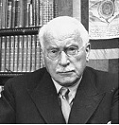 Good evening, and welcome to BBC radio 4. I’m Professor David Stephenson, professor of Dutch historical studies at Cambridge. This is the eighth part of our 50 episode special on the second 80 years war over Europe. Joining me for these broadcasts are fellow researchers and scholars Doctor Albert Andrews, specialist in German studies from the Berlin academy, Professor Robert Lowe, specialist in French studies at Cambridge, and a graduate student and technical assistant, Anton Thatcher. Last week, we discussed the Battle of Nancy, the last stand of France, and the growing ambitions of the Dutch.
Good evening, and welcome to BBC radio 4. I’m Professor David Stephenson, professor of Dutch historical studies at Cambridge. This is the eighth part of our 50 episode special on the second 80 years war over Europe. Joining me for these broadcasts are fellow researchers and scholars Doctor Albert Andrews, specialist in German studies from the Berlin academy, Professor Robert Lowe, specialist in French studies at Cambridge, and a graduate student and technical assistant, Anton Thatcher. Last week, we discussed the Battle of Nancy, the last stand of France, and the growing ambitions of the Dutch. With Europe either under the boot heel of the Dutch armies, distracted by their own fighting through central Germany, or far too far away from Holland to threaten the Western Atlantic Federation, the Dutch had turned their eyes abroad to the gem of India, and to the last Spanish colonies in the Americas. Their trade had reached nearly monopolistic levels at a global scale.
With Europe either under the boot heel of the Dutch armies, distracted by their own fighting through central Germany, or far too far away from Holland to threaten the Western Atlantic Federation, the Dutch had turned their eyes abroad to the gem of India, and to the last Spanish colonies in the Americas. Their trade had reached nearly monopolistic levels at a global scale.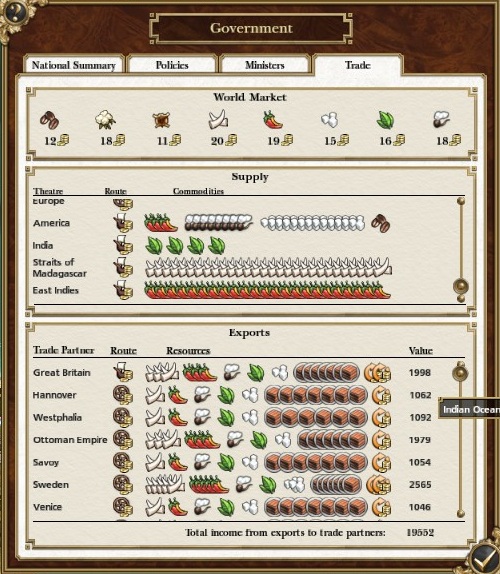
The Dutch trade income as of 1714. They had a monopoly on ivory.
 While the Crumbling and desperate Spanish colonies looked like easy prey, the Marathas, proud and mighty among the kingdoms in the Middle East and India were casual and flippant beside the meager armies of the Dutch. Outnumbering the V.O.C. force by as many as twenty to one, the old armies of the Marathas had every reason to feel confident at the small republic that would land on their shores.
While the Crumbling and desperate Spanish colonies looked like easy prey, the Marathas, proud and mighty among the kingdoms in the Middle East and India were casual and flippant beside the meager armies of the Dutch. Outnumbering the V.O.C. force by as many as twenty to one, the old armies of the Marathas had every reason to feel confident at the small republic that would land on their shores.
The Spanish had collapsed to the point that they could no longer garrison her colonies.
 The Dutch declared war under absolutely no pretense on September 26, 1714 on the kingdom of Mysore, an ally of the Marathas. The Dutch made their landing in the Maratha port of Calicut in southern India, violating their territorial sovereignty. The Marathas were incensed by this act, and declared war on the Dutch September 29, but the Dutch paid them off at considerable expense to reconsider.
The Dutch declared war under absolutely no pretense on September 26, 1714 on the kingdom of Mysore, an ally of the Marathas. The Dutch made their landing in the Maratha port of Calicut in southern India, violating their territorial sovereignty. The Marathas were incensed by this act, and declared war on the Dutch September 29, but the Dutch paid them off at considerable expense to reconsider.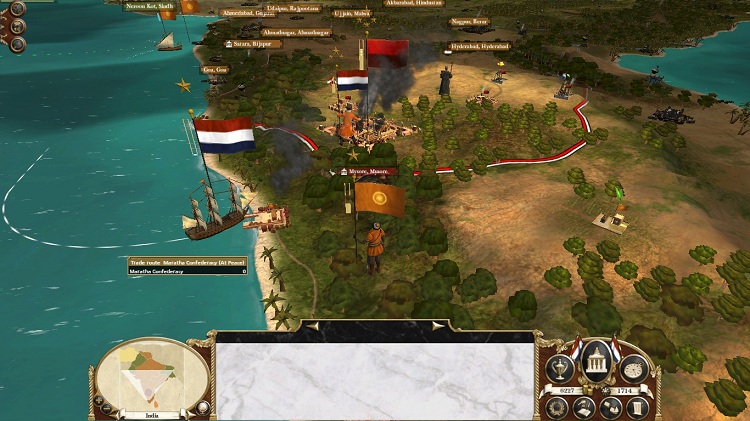
The Dutch army used the Maratha port of Calicut to save valuable time disembarking their army. The speed of the attack completely catches the city state of Mysore by surprise.
 Maratha neutrality declared, Mysore was put into a desperate position. They had their fortified army in the capitol city of Mysore, and another to the North near the border of Goa, the honour guard of Prince Japreet Yamandreddy who had been to Goa on a consulate visit to the Marathas.
Maratha neutrality declared, Mysore was put into a desperate position. They had their fortified army in the capitol city of Mysore, and another to the North near the border of Goa, the honour guard of Prince Japreet Yamandreddy who had been to Goa on a consulate visit to the Marathas.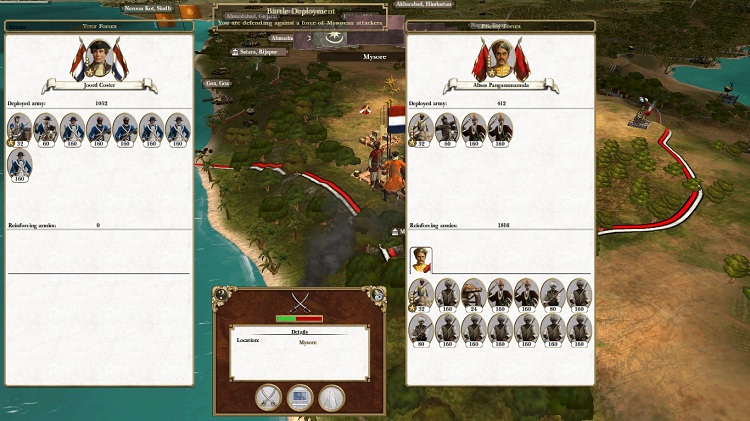
The Mysore armies meet up to life the siege of Mysore.
 The Dutch had established the siege at Mysore, but had not yet assaulted the walls. They were unaware that the Prince had a separate army contingent north of them, and had thought to starve them out. This allowed Japreet the opportunity to march south to try to join forces with the main garrison, and to join up with the city guard. The Dutch also had no cannon, and as such had to do a long siege of the city, rather than assault it.
The Dutch had established the siege at Mysore, but had not yet assaulted the walls. They were unaware that the Prince had a separate army contingent north of them, and had thought to starve them out. This allowed Japreet the opportunity to march south to try to join forces with the main garrison, and to join up with the city guard. The Dutch also had no cannon, and as such had to do a long siege of the city, rather than assault it. The Dutch, having caught sight of the second Mysore army quickly redeployed their forces further south of the walls, letting the Mysore armies regroup. Moving forward against the redeployed and prepared Dutch, and having no sense of a modern European army, the Mysore prince led a strong cavalry and elephant charge against the Dutch. Still clinging to the ancient idea that the cavalry could be used to simply shatter the infantry, they charged for honour and glory.
The Dutch, having caught sight of the second Mysore army quickly redeployed their forces further south of the walls, letting the Mysore armies regroup. Moving forward against the redeployed and prepared Dutch, and having no sense of a modern European army, the Mysore prince led a strong cavalry and elephant charge against the Dutch. Still clinging to the ancient idea that the cavalry could be used to simply shatter the infantry, they charged for honour and glory.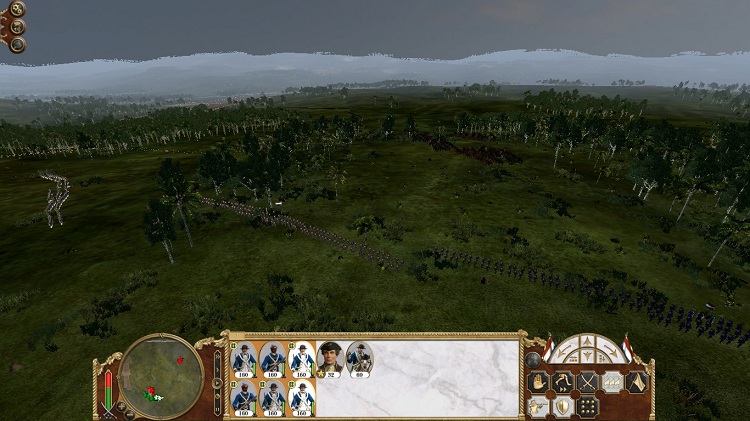
The cavalry charges forward, assuming the unarmoured "peasants" would scatter at their charge.
 Many of the elephants, cavalry and the prince’ guards were shot down in mass volleys from the Dutch lines in just a moment. Japreet was killed when his elephant was shot from under him, and the remainder of his guard trampled him to death in the confusion. Spurred onward from the city commander, the remaining mob of infantry, almost all of whom were armed with swords and little else charged forward towards the disciplined line infantry.
Many of the elephants, cavalry and the prince’ guards were shot down in mass volleys from the Dutch lines in just a moment. Japreet was killed when his elephant was shot from under him, and the remainder of his guard trampled him to death in the confusion. Spurred onward from the city commander, the remaining mob of infantry, almost all of whom were armed with swords and little else charged forward towards the disciplined line infantry.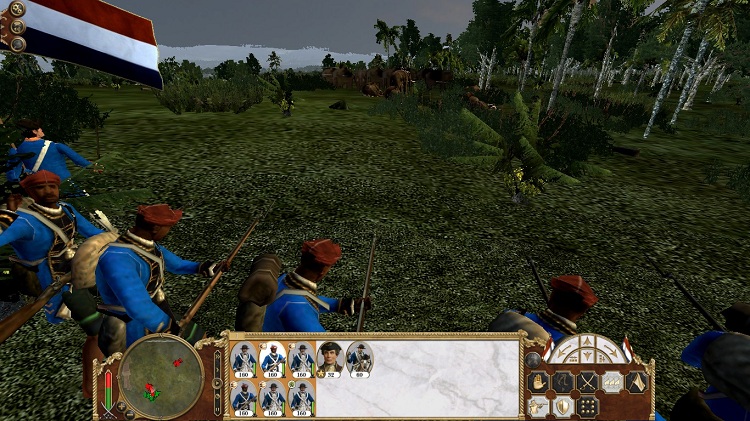
The Dutch Sepoy infantry fire at the Mysore elephants. The former terrors of the battlefield have no defense against the mass fire power of the muskets.
 It was a catastrophe. Even though the Indian army outnumbered the Dutch two to one, they were repulsed at every charge, the poor swordsmen routing under the curtains of fire from the Dutch lines. Even though many would rally, they did so only to encounter another curtain of fire as they returned to the battle. Men were mown down in droves, and the hundred yards in front of the Dutch lines were littered with corpses. When their resolve had finally completely shattered, there were only a few hundred men left alive, both their Prince and the city commander lay dead in the field, and the Dutch troops were hardly reduced at all.
It was a catastrophe. Even though the Indian army outnumbered the Dutch two to one, they were repulsed at every charge, the poor swordsmen routing under the curtains of fire from the Dutch lines. Even though many would rally, they did so only to encounter another curtain of fire as they returned to the battle. Men were mown down in droves, and the hundred yards in front of the Dutch lines were littered with corpses. When their resolve had finally completely shattered, there were only a few hundred men left alive, both their Prince and the city commander lay dead in the field, and the Dutch troops were hardly reduced at all.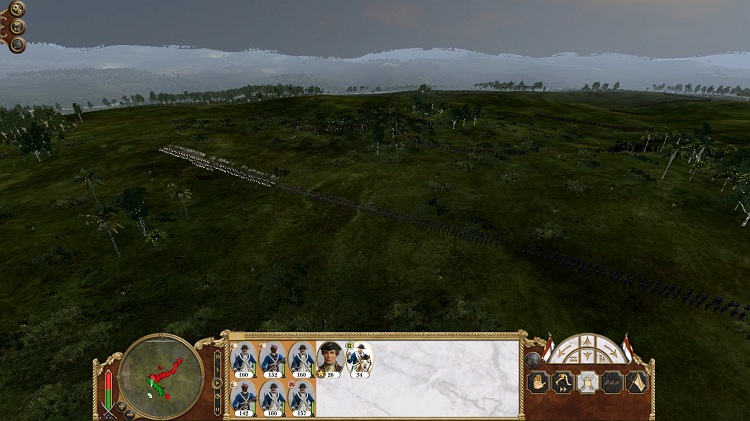
A mass volley slaughters the oncoming sword armed citizens.
 By the end of the day, the Dutch had repelled over a dozen charges from sword armed Indians, and had killed 1700 men to merely 300 losses, and had irrefutably proven that the gun is indeed mightier than the sword, no matter how skilled the swordsman. The fragments of the Indian army retreated back into the walls of Mysore.
By the end of the day, the Dutch had repelled over a dozen charges from sword armed Indians, and had killed 1700 men to merely 300 losses, and had irrefutably proven that the gun is indeed mightier than the sword, no matter how skilled the swordsman. The fragments of the Indian army retreated back into the walls of Mysore.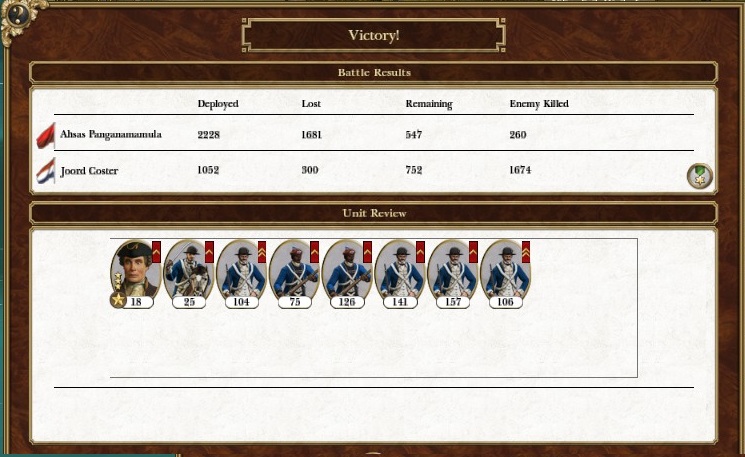
The remaining Dutch now outnumbered the Mysore forces. The Dutch had very coincidentally lost exactly 300 men.
 The king of Mysore sent out his envoys to beg peace from the Dutch, offering an immense sum of eleven million guilders if the Dutch would show mercy. Cooster however, knew that the lump sum was nowhere near the riches they could take from India if they managed to get their toehold on the mainland, and the attack continued. The forces of Mysore, huddled in their fortifications could only await the inevitable.
The king of Mysore sent out his envoys to beg peace from the Dutch, offering an immense sum of eleven million guilders if the Dutch would show mercy. Cooster however, knew that the lump sum was nowhere near the riches they could take from India if they managed to get their toehold on the mainland, and the attack continued. The forces of Mysore, huddled in their fortifications could only await the inevitable.
Mysore sues for peace. Since their lands and their possessions are all that interest the Dutch for now, no peace is to be had.
 The assault outside the city walls had proven futile, and the greatly depleted garrison had simply meant the Dutch no longer had to siege out the Mysore forces, and so the Mysore army didn’t have to wait long. The Dutch advanced in heavy columns rather than thin lines. Their commanding officer, Joord Coster wanted his men to take the walls as fast as possible, and had no intention of wasting shots covering his men’s climb up the walls. Predominantly sword armed men lined the walls anyhow, and couldn't have fired down at the advancing V.O.C. infantry anyhow.
The assault outside the city walls had proven futile, and the greatly depleted garrison had simply meant the Dutch no longer had to siege out the Mysore forces, and so the Mysore army didn’t have to wait long. The Dutch advanced in heavy columns rather than thin lines. Their commanding officer, Joord Coster wanted his men to take the walls as fast as possible, and had no intention of wasting shots covering his men’s climb up the walls. Predominantly sword armed men lined the walls anyhow, and couldn't have fired down at the advancing V.O.C. infantry anyhow.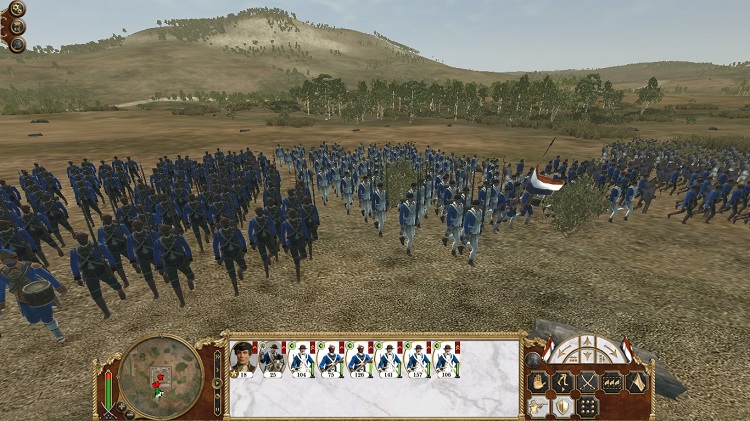
Dutch columns advancing on the city of Mysore. Columns could travel faster than lines, and were more durable in a melee assault.
 The columns of line infantry managed to scale the walls without incident, encountering a small amount of sword and firelock armed rabble, which were both easily dispatched. After gaining the walls, Dutch troops were able to see the Indian troops holding up in a mass square in the center of the fort, hoping to hold out against a Dutch assault to capture it.
The columns of line infantry managed to scale the walls without incident, encountering a small amount of sword and firelock armed rabble, which were both easily dispatched. After gaining the walls, Dutch troops were able to see the Indian troops holding up in a mass square in the center of the fort, hoping to hold out against a Dutch assault to capture it.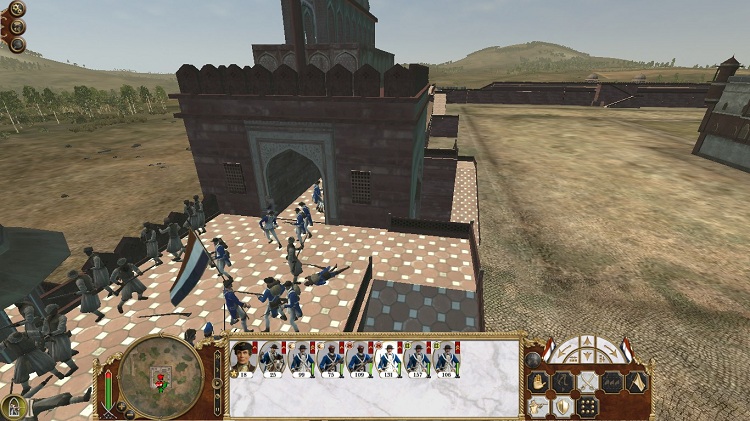
The Dutch troops take the walls from poorly armed civilians.
 The Dutch V.O.C. lined up on the walls, using the fortifications to fire inward while sepoys moved down from the fortifications to form a firing line in the square. The Dutch had opened with a volley of gun fire rather than try to charge the enemy’s strong point.
The Dutch V.O.C. lined up on the walls, using the fortifications to fire inward while sepoys moved down from the fortifications to form a firing line in the square. The Dutch had opened with a volley of gun fire rather than try to charge the enemy’s strong point.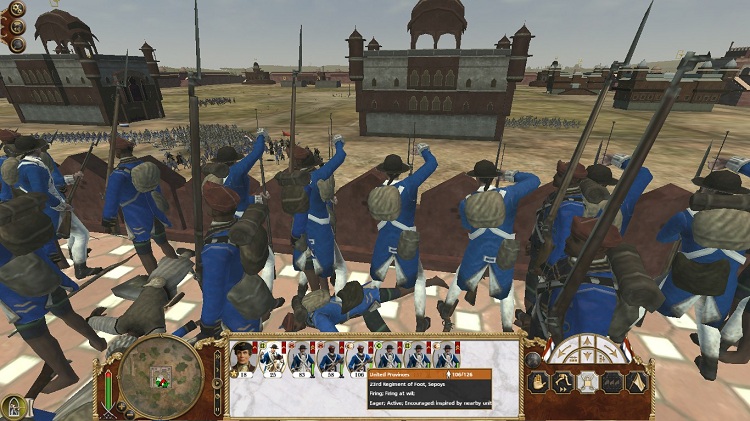
V.O.C. use the wall's fortifications to fire into the central courtyard.
 The Mysore troops could only respond by charging directly at the Dutch lines in a desperate push. Their melee charge managed to crash against the Dutch, some of whom had held up in the captured armoury. However, the Dutch numbers were such that the firing line could still fire in many places, even as the V.O.C. infantry cut the swordsmen down with their bayonets.
The Mysore troops could only respond by charging directly at the Dutch lines in a desperate push. Their melee charge managed to crash against the Dutch, some of whom had held up in the captured armoury. However, the Dutch numbers were such that the firing line could still fire in many places, even as the V.O.C. infantry cut the swordsmen down with their bayonets.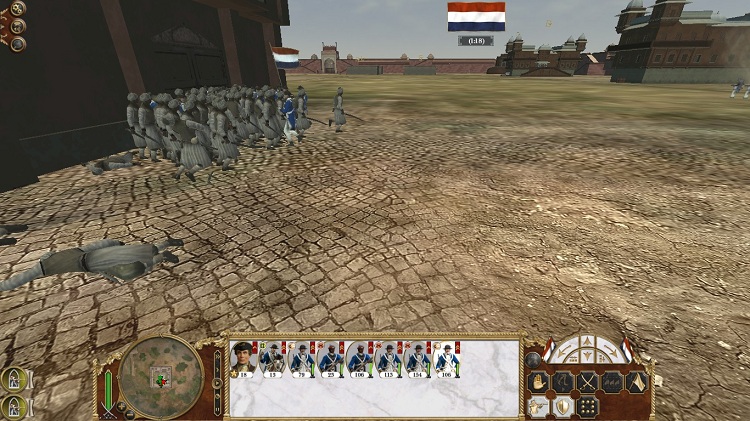
Sword armed citizens try to retake the armoury as V.O.C. fire from the windows. A few Dutch soldiers are caught outside and cut down, including their regimental standard bearer.
 After a mere half hour of fighting, Joord Coster and his cavalry parade into the middle of the fortress, bullets still whizzing about, and men still fighting bayonet to saber. He and his guard raised the flag of the United Provinces, taking down the Mysore flag. Upon seeing this, the morale of the few remaining guard broke, and the garrison finally surrendered.
After a mere half hour of fighting, Joord Coster and his cavalry parade into the middle of the fortress, bullets still whizzing about, and men still fighting bayonet to saber. He and his guard raised the flag of the United Provinces, taking down the Mysore flag. Upon seeing this, the morale of the few remaining guard broke, and the garrison finally surrendered.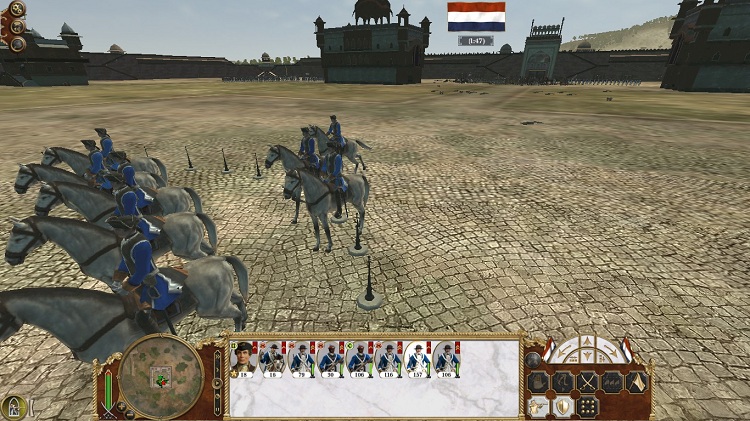
Joord Coster and his guard take the courtyard.
 The country of Mysore was more or less a land of potential. Its economy was already staggering, earning the Dutch millions of guilders every year, but it also had many mines, factories and schools that were technologically backward.
The country of Mysore was more or less a land of potential. Its economy was already staggering, earning the Dutch millions of guilders every year, but it also had many mines, factories and schools that were technologically backward.
Mysore was the economic heartland of India, even more so than the economic centers controlled by the Marathas.
 The economic potential was to take a back seat to the military potential however. Mysore began producing troops by the hundreds, V.O.C. infantry and sepoys were recruited by the hundreds to prepare the Dutch for an attack on the Marathas.
The economic potential was to take a back seat to the military potential however. Mysore began producing troops by the hundreds, V.O.C. infantry and sepoys were recruited by the hundreds to prepare the Dutch for an attack on the Marathas. The Marathas were suspicious of Dutch intentions at the time. However, as they had tens of thousands of their best infantry north to fight the Mughal Empire, they could do little but accept the Dutch presence on their door step. They weren’t without caution however, and many more infantry were recruited during that time.
The Marathas were suspicious of Dutch intentions at the time. However, as they had tens of thousands of their best infantry north to fight the Mughal Empire, they could do little but accept the Dutch presence on their door step. They weren’t without caution however, and many more infantry were recruited during that time. The Dutch weren’t only interested in the East. In the West, Dutch marines and some native militia were sent to Cuba, finding the lucrative trade island had virtually no garrison. The meagre forces on the island were willing to surrender, demoralized by news of Spanish failures all across their empire. They also took over the equally poorly defended province of New Grenada, which was a lucrative mining region with a strong industrial base. The only resistance they faced was a galleon who contested the landing of the fleet to New Grenada, but was defeated by the Dutch 6th rates.
The Dutch weren’t only interested in the East. In the West, Dutch marines and some native militia were sent to Cuba, finding the lucrative trade island had virtually no garrison. The meagre forces on the island were willing to surrender, demoralized by news of Spanish failures all across their empire. They also took over the equally poorly defended province of New Grenada, which was a lucrative mining region with a strong industrial base. The only resistance they faced was a galleon who contested the landing of the fleet to New Grenada, but was defeated by the Dutch 6th rates.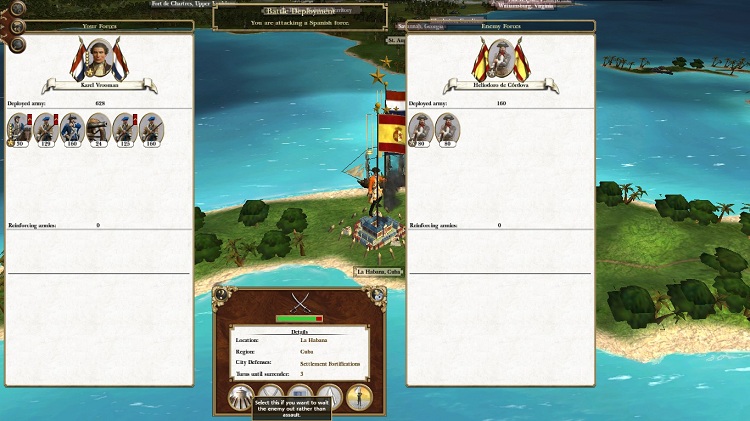
The Dutch arrive in Cuba only to find it bereft of soldiers. A few old men with guns from the time of Cortes the conquistador mill about, but are more than willing to surrender.
 The fight for Cuba and New Grenada seemed incredibly incidental, but the Dutch viewed Cuba as a key strategic asset. With several straight years of saturation in the sugar market, the Dutch had to do something to justify their continued expenses in the Americas. Their answer was the tobacco market, which had risen in prices with falling confidence in the ability of the Spanish to provide the supply of it. The only other producer of tobacco being the British in a very few states within the former 13 colonies, but these were not heavily invested in.
The fight for Cuba and New Grenada seemed incredibly incidental, but the Dutch viewed Cuba as a key strategic asset. With several straight years of saturation in the sugar market, the Dutch had to do something to justify their continued expenses in the Americas. Their answer was the tobacco market, which had risen in prices with falling confidence in the ability of the Spanish to provide the supply of it. The only other producer of tobacco being the British in a very few states within the former 13 colonies, but these were not heavily invested in.
Cuba is famous for its quality tobacco and cigars. The Dutch empire made a fortune off of them.
 After taking Cuba, the Dutch immediately expanded the plantations, reorganizing the businesses and pouring millions of guilders into the tiny island. Tobacco was a strong investment to the Dutch, as the factory workers liked smoking constantly. New industrial factories with their brick walls and smoke stacks mingled with the tobacco smoke in the big industrial cities. What’s more, with the increase in wealth, it was popular to spend time smoking and drinking in high society.
After taking Cuba, the Dutch immediately expanded the plantations, reorganizing the businesses and pouring millions of guilders into the tiny island. Tobacco was a strong investment to the Dutch, as the factory workers liked smoking constantly. New industrial factories with their brick walls and smoke stacks mingled with the tobacco smoke in the big industrial cities. What’s more, with the increase in wealth, it was popular to spend time smoking and drinking in high society.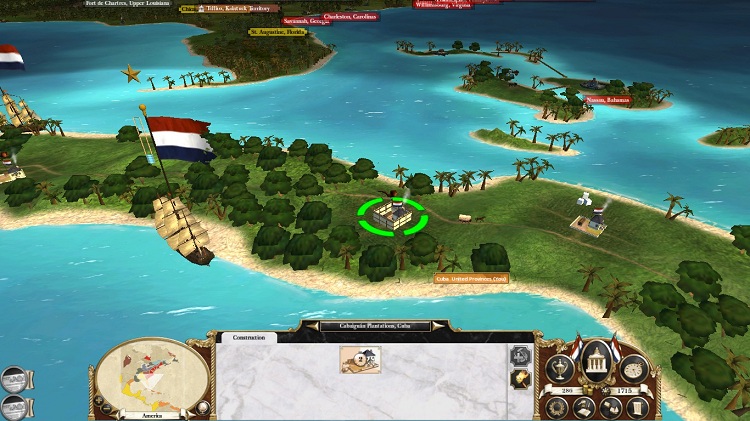
The Dutch immediately remodeled and rebuilt the Cuban Tobacco plantations to improve their output.
 Of course, the monetary motivation may have been masking more than a little spite. Shortly after, the Spanish holdout of Sardinia, which had absolutely no economic value was also sacked. Unlike Cuba, which was scarcely garrisoned, Sardinia was staunchly defended. The Spanish monarchy was absolutely desperate to hold on to their very limited European holdings. Being a European power granted prestige and legitimacy to a rule.
Of course, the monetary motivation may have been masking more than a little spite. Shortly after, the Spanish holdout of Sardinia, which had absolutely no economic value was also sacked. Unlike Cuba, which was scarcely garrisoned, Sardinia was staunchly defended. The Spanish monarchy was absolutely desperate to hold on to their very limited European holdings. Being a European power granted prestige and legitimacy to a rule. A small force set sail from Spain in the spring of 1716. With sufficient garrison to keep the populace in line, the Dutch were free to move about and dominate the Mediterranean. Landing in Sardinia, the Dutch forces once again were dominant enough to actually assault the fortress.
A small force set sail from Spain in the spring of 1716. With sufficient garrison to keep the populace in line, the Dutch were free to move about and dominate the Mediterranean. Landing in Sardinia, the Dutch forces once again were dominant enough to actually assault the fortress.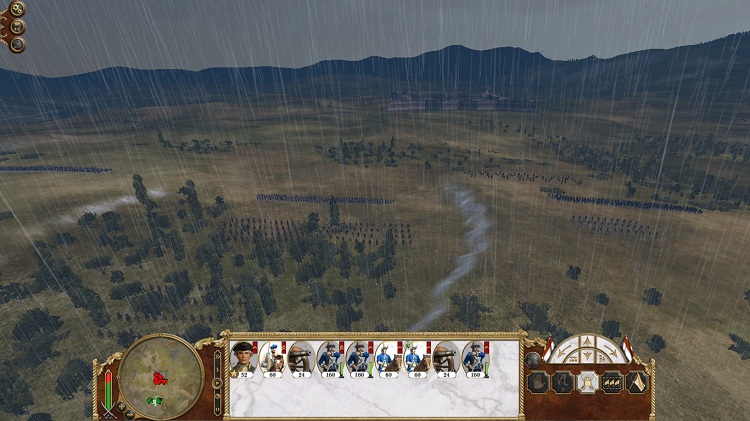
The Dutch feel confident that their forces can directly assault the tiny garrison at Sardinia.
 While the Spanish had approximately the same numbers, once again, the quality of the troops in question were the decisive factor. The Dutch had their powerful 12 pound cannons, and disciplined line infantry. The Spanish had to rely primarily on their very poor firelock armed citizenry.
While the Spanish had approximately the same numbers, once again, the quality of the troops in question were the decisive factor. The Dutch had their powerful 12 pound cannons, and disciplined line infantry. The Spanish had to rely primarily on their very poor firelock armed citizenry.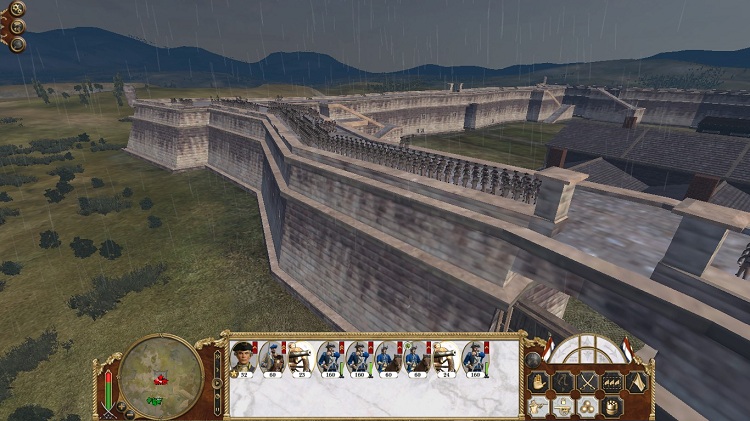
Once again, the Dutch are faced only with poorly armed citizens. Part of their general strategy by this time was avoiding fights against military powers and instead fight against provinces without an army.
 The Dutch were able to pound away at the Spanish walls for hours on end. Without the ability to retaliate, the Spanish could do nothing but sit and wait as their walls were torn apart around them. The right wall facing the Dutch was torn down, and the Dutch army set out with their guns ranged into the breach. Their cannons spent hours firing grape into the breach, quickly killing anyone trying to prevent the Dutch entry.
The Dutch were able to pound away at the Spanish walls for hours on end. Without the ability to retaliate, the Spanish could do nothing but sit and wait as their walls were torn apart around them. The right wall facing the Dutch was torn down, and the Dutch army set out with their guns ranged into the breach. Their cannons spent hours firing grape into the breach, quickly killing anyone trying to prevent the Dutch entry.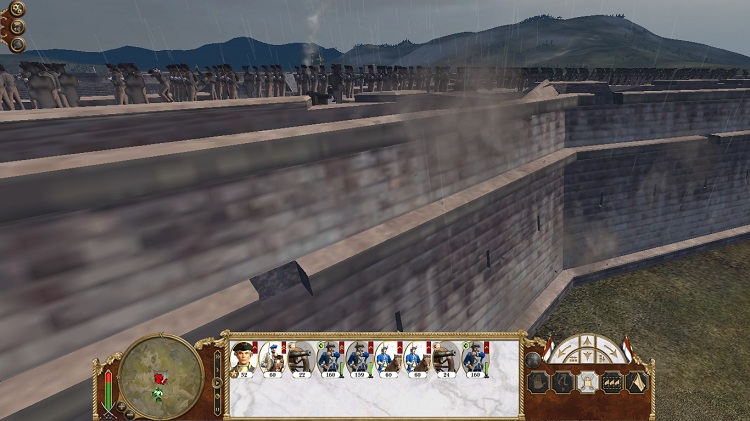
The walls are battered by the 12 pound cannon balls.
 The Spanish cavalry sallied forth several times, trying to get to the cannons and end the relentless patter of grape shot into their lines, but they were pushed back into the fortress by the volley fire of the Dutch line infantry.
The Spanish cavalry sallied forth several times, trying to get to the cannons and end the relentless patter of grape shot into their lines, but they were pushed back into the fortress by the volley fire of the Dutch line infantry.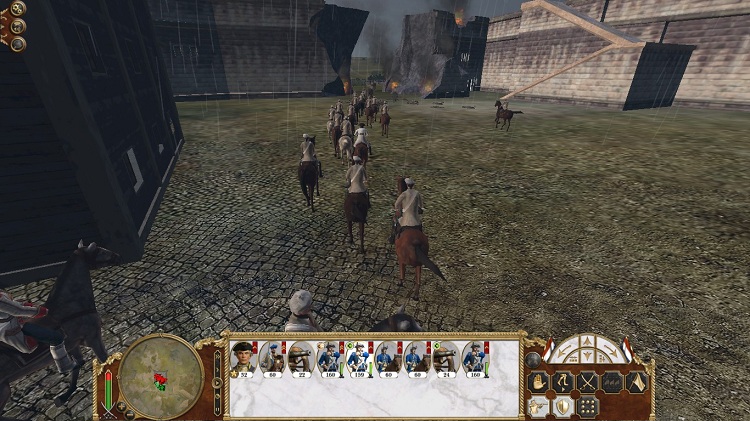
Desperate to end the artillery, the Spanish Gendarme move out to try and take the cannons out with them in a suicidal charge.
 Eventually, the Spanish were forced to retire from the breach, retreating to the city center. The Dutch, seeing an opportunity rushed their entire force into the breach and went into firing lines in the city, and even though a brief but bloody melee broke out, the Dutch had whittled away so many hundreds of men that they were able to smash their way through them and raise the Dutch flag. None of the Spanish defenders were left alive.
Eventually, the Spanish were forced to retire from the breach, retreating to the city center. The Dutch, seeing an opportunity rushed their entire force into the breach and went into firing lines in the city, and even though a brief but bloody melee broke out, the Dutch had whittled away so many hundreds of men that they were able to smash their way through them and raise the Dutch flag. None of the Spanish defenders were left alive.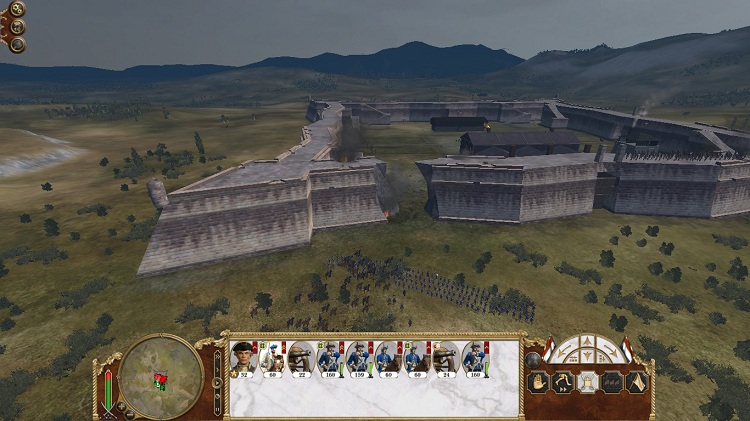
Dutch forces have cleared the breach in a hail of shot. The rush in to secure the fort.
 Now, the Spanish existed only in the tiny region of Milan. Nestled around the Austrian Empire and the tiny nation of Genoa, they were at least somewhat shielded from the Dutch, who seemed intent on stamping them out completely. However, their power was clearly waning. The only hold they had was over their increasingly totalitarian governors and generals in the Americas. Too far and too weak to threaten a coup against Spain, and unable to turn on one another for fear of the Dutch, the rebellious Spanish Americas were only barely held together. One more tiny push would see them taken apart completely. That final stroke loomed close as the Dutch prepared their forces to move out to Milan.
Now, the Spanish existed only in the tiny region of Milan. Nestled around the Austrian Empire and the tiny nation of Genoa, they were at least somewhat shielded from the Dutch, who seemed intent on stamping them out completely. However, their power was clearly waning. The only hold they had was over their increasingly totalitarian governors and generals in the Americas. Too far and too weak to threaten a coup against Spain, and unable to turn on one another for fear of the Dutch, the rebellious Spanish Americas were only barely held together. One more tiny push would see them taken apart completely. That final stroke loomed close as the Dutch prepared their forces to move out to Milan. Conquest after conquest. It had almost seemed too easy for the United Provinces. But within the next few years, the Dutch will find themselves entrenched in the largest war the world had ever seen.
Conquest after conquest. It had almost seemed too easy for the United Provinces. But within the next few years, the Dutch will find themselves entrenched in the largest war the world had ever seen. In our next broadcast, we present the fall of Spain, and the start of the 80 years war. Next is the live broadcast of the launch of the Regency 5. In half an hour, we will be presenting world news. If you want news of the current war in the Middle East please channel in to BBC radio 1. David Stephenson will be presenting more on the 80 years war in 3 days.
In our next broadcast, we present the fall of Spain, and the start of the 80 years war. Next is the live broadcast of the launch of the Regency 5. In half an hour, we will be presenting world news. If you want news of the current war in the Middle East please channel in to BBC radio 1. David Stephenson will be presenting more on the 80 years war in 3 days.